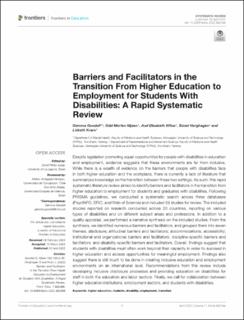| dc.contributor.author | Goodall, Gemma | |
| dc.contributor.author | Mjøen, Odd Morten | |
| dc.contributor.author | Witsø, Aud Elisabeth | |
| dc.contributor.author | Horghagen, Sissel | |
| dc.contributor.author | Kvam, Lisbeth | |
| dc.date.accessioned | 2023-01-26T14:57:09Z | |
| dc.date.available | 2023-01-26T14:57:09Z | |
| dc.date.created | 2022-04-26T08:28:37Z | |
| dc.date.issued | 2022 | |
| dc.identifier.citation | Frontiers in Education. 2022, 7 1-15. | en_US |
| dc.identifier.issn | 2504-284X | |
| dc.identifier.uri | https://hdl.handle.net/11250/3046667 | |
| dc.description.abstract | Despite legislation promoting equal opportunities for people with disabilities in education and employment, evidence suggests that these environments are far from inclusive. While there is a wealth of evidence on the barriers that people with disabilities face in both higher education and the workplace, there is currently a lack of literature that summarizes knowledge on the transition between these two settings. As such, this rapid systematic literature review aimed to identify barriers and facilitators in the transition from higher education to employment for students and graduates with disabilities. Following PRISMA guidelines, we conducted a systematic search across three databases (PsycINFO, ERIC, and Web of Science) and included 59 studies for review. The included studies reported on research conducted across 20 countries, reporting on various types of disabilities and on different subject areas and professions. In addition to a quality appraisal, we performed a narrative synthesis on the included studies. From the synthesis, we identified numerous barriers and facilitators, and grouped them into seven themes: disclosure; attitudinal barriers and facilitators; accommodations, accessibility; institutional and organizational barriers and facilitators; discipline-specific barriers and facilitators; and disability-specific barriers and facilitators. Overall, findings suggest that students with disabilities must often work beyond their capacity in order to succeed in higher education and access opportunities for meaningful employment. Findings also suggest there is still much to be done in creating inclusive education and employment environments on an international level. Recommendations from this review include developing inclusive disclosure processes and providing education on disabilities for staff in both the education and labor sectors. Finally, we call for collaboration between higher education institutions, employment sectors, and students with disabilities. | en_US |
| dc.language.iso | eng | en_US |
| dc.publisher | Frontiers Media | en_US |
| dc.rights | Navngivelse 4.0 Internasjonal | * |
| dc.rights.uri | http://creativecommons.org/licenses/by/4.0/deed.no | * |
| dc.title | Barriers and Facilitators in the Transition From Higher Education to Employment for Students With Disabilities: A Rapid Systematic Review | en_US |
| dc.title.alternative | Barriers and Facilitators in the Transition From Higher Education to Employment for Students With Disabilities: A Rapid Systematic Review | en_US |
| dc.type | Peer reviewed | en_US |
| dc.type | Journal article | en_US |
| dc.description.version | publishedVersion | en_US |
| dc.source.pagenumber | 1-15 | en_US |
| dc.source.volume | 7 | en_US |
| dc.source.journal | Frontiers in Education | en_US |
| dc.identifier.doi | 10.3389/feduc.2022.882066 | |
| dc.identifier.cristin | 2019073 | |
| dc.relation.project | Norges forskningsråd: 303710 | en_US |
| cristin.ispublished | true | |
| cristin.fulltext | original | |
| cristin.qualitycode | 1 | |

